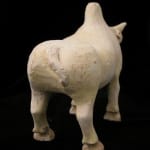T'ang Painted Terracotta Sculpture of a Zebu Bull, 618 CE - 906 CE
Painted Terracotta
7.75
H.945
Further images
The T’ang Dynasty was an era of unrivalled wealth and luxury. The country was successfully reunified and the borders were expanded, pushing Chinese influence into new lands. Confucianism became a...
The T’ang Dynasty was an era of unrivalled wealth and luxury. The country was successfully reunified and the borders were expanded, pushing Chinese influence into new lands. Confucianism became a semi-religious instrument of the state; yet Buddhism continued to flourish, spreading into Korea and Japan. The arts reached new levels of sophistication. Poetry and literature flourished under the enlightened rulers. The Silk Road brought fortunes into China. Precious treasures were imported on the backs of camels from far away lands and bartered for Chinese silk, medicinal herbs, and pungent spices. T’ang China was a multicultural empire where foreign merchants from across Central Asia and the Middle East settled in the urban centers, foremost among them the thriving capital of Chang’an (modern X’ian), a bustling cosmopolitan center of over two million inhabitants. Foreign traders lived next to native artisans and both thrived. New ideas and exotic artistic forms followed alongside. The T’ang Dynasty was a cultural renaissance where many of the forms and objects we now associate with China were first created. Moreover, this period represents one of the greatest cultural outpourings in human history.
During the T’ang Dynasty, sculptural effigies of domesticated animals were often interred in the tombs of nobility and elite members of the social hierarchy. Created in all media, these sculptures accompanied the spirit of the deceased into the afterlife. While similar examples exist, most were found harnessed to wagons and carts and were meant to function as beasts of burden. However, this sculpture was discovered buried with other domesticated animals, suggesting that this zebu bull served as nourishment. Besides it function, this sculpture is also remarkable for its exquisite state of preservation with much of its original yellow pigment still intact. Such delicate decoration rarely survives the ravages of time and the stresses of excavation. Some of the original red pigment that also once adorned the animal is also visible on its nose. During the T’ang Dynasty, the Chinese believed that the afterlife was a continuation of our earthly existence. Thus, logically, as we require food to nourish our bodies on earth, so too will we require food to nourish our souls in the afterlife. Created to serve as food for the afterlife, this work is more than a mere sculpture; it is a gorgeous memorial to the religious and philosophical beliefs of the T’ang Dynasty. This bull effigy has served its eternal purpose well. Today, it continues to nourish our souls with its beauty and grace.
During the T’ang Dynasty, sculptural effigies of domesticated animals were often interred in the tombs of nobility and elite members of the social hierarchy. Created in all media, these sculptures accompanied the spirit of the deceased into the afterlife. While similar examples exist, most were found harnessed to wagons and carts and were meant to function as beasts of burden. However, this sculpture was discovered buried with other domesticated animals, suggesting that this zebu bull served as nourishment. Besides it function, this sculpture is also remarkable for its exquisite state of preservation with much of its original yellow pigment still intact. Such delicate decoration rarely survives the ravages of time and the stresses of excavation. Some of the original red pigment that also once adorned the animal is also visible on its nose. During the T’ang Dynasty, the Chinese believed that the afterlife was a continuation of our earthly existence. Thus, logically, as we require food to nourish our bodies on earth, so too will we require food to nourish our souls in the afterlife. Created to serve as food for the afterlife, this work is more than a mere sculpture; it is a gorgeous memorial to the religious and philosophical beliefs of the T’ang Dynasty. This bull effigy has served its eternal purpose well. Today, it continues to nourish our souls with its beauty and grace.







